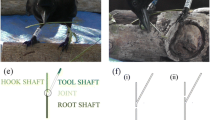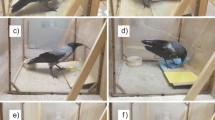Abstract
One important element of complex and flexible tool use, particularly where tool manufacture is involved, is the ability to select or manufacture appropriate tools anticipating the needs of any given task—an ability that has been rarely tested in non-primates. We examine aspects of this ability in New Caledonian crows—a species known to be extraordinary tool users and manufacturers. In a 2002 study, Chappell and Kacelnik showed that these crows were able to select a tool of the appropriate length for a task among a set of different lengths, and in 2002, Weir, Chappell and Kacelnik showed that New Caledonian crows were able to shape unfamiliar materials to create a usable tool for a specific task. Here we examine their handling of tool diameter. In experiment 1, we show that when facing three loose sticks that were usable as tools, they preferred the thinnest one. When the three sticks were presented so that one was loose and the other two in a bundle, they only disassembled the bundle when their preferred tool was tied. In experiment 2, we show that they manufacture, and modify during use, a tool of a suitable diameter from a tree branch, according to the diameter of the hole through which the tool will have to be inserted. These results add to the developing picture of New Caledonian crows as sophisticated tool users and manufacturers, having an advanced level of folk physics.




Similar content being viewed by others
References
Anderson JR, Henneman MC (1994) Solutions to a tool-use problem in a pair of Cebus apella. Mammalia 58:351–361
Aumann T (1990) Use of stones by the Black-breasted Buzzard Hamirostra melanosternon to gain access to egg contents for food. Emu 90:141–144
Beck BB (1980) Animal tool use: the use and manufacture of tools by animals. Garland, New York
Bermejo M, Illera G (1999) Tool-set for termite-fishing and honey extraction by wild chimpanzees in the Lossi Forest, Congo. Primates 40:619–627
Bowman R (1961) Morphological differentiation and adaptation in the Galapagos finches. Univ Calif Publ Zool 58:1–326
Boysen ST, Kuhlmeier VA, Halliday P, Halliday YM (1999) Tool use in captive gorillas. In: Parker ST, Mitchell RW (eds) The mentalities of gorillas and orangutans: comparative perspectives. Cambridge University Press, New York, N.Y., pp 179–187
Chappell J, Kacelnik A (2002) Tool selectivity in a non-mammal, the New Caledonian crow (Corvus moneduloides). Anim Cogn 5:71–78
Fox EA, Sitompul AF, Van Schaik CP (1999) Intelligent tool use in wild Sumatran orangutans. In: Parker ST, Mitchell RW(eds) The mentalities of gorillas and orangutans: comparative perspectives. Cambridge University Press, New York, N.Y., pp 99–116
Hunt GR (1996) Manufacture and use of hook-tools by New Caledonian crows. Nature 379:249–251
Hunt GR (2000a) Human-like, population-level specialization in the manufacture of pandanus tools by New Caledonian crows Corvus moneduloides. Proc R Soc Lond B 267:403–413
Hunt GR (2000b) Tool use by the New Caledonian crow Corvus moneduloides to obtain Cerambycidae from dead wood. Emu 100:109–114
Hunt GR, Gray RD (2002) Species-wide manufacture of stick-type tools by New Caledonian Crows. Emu 102:349–353
Hunt GR, Gray RD (2003) Diversification and cumulative evolution in New Caledonian crow tool manufacture. Proc R Soc Lond B 270:867–874
Hunt GR, Corballis MC, Gray RD (2001) Laterality in tool manufacture by crows. Nature 414:707
Lavallee AC (1999) Capuchin (Cebus apella) tool use in a captive naturalistic environment. Int J Primatol 20:399–414
Lefebvre L, Nicolakakis N, Boire D (2002) Tools and brains in birds. Behaviour 139:939–973
Parker ST, Gibson KR (1977) Object manipulation, tool use and sensorimotor intelligence as feeding adaptations in Cebus monkeys and great apes. J Hum Evol 6:623–641
Povinelli DJ (2000) Folk physics for apes: a chimpanzee’s theory of how the world works. Oxford University Press, Oxford
Thouless CR, Fanshawe JH, Bertram BCR (1989) Egyptian vultures Neophron percnopterus and Ostrich Struthio camelus eggs—the origins of stone-throwing behavior. Ibis 131:9–15
Tomasello M, Call J (1997) Primate cognition. Oxford University Press, New York
Visalberghi E, Fragaszy DM, Savage-Rumbaugh ES (1995) Performance in a tool-using task by common chimpanzees (Pan troglodytes), bonobos (Pan paniscus), an orangutan (Pongo pygmaeus), and capuchin monkeys (Cebus apella). J Comp Psychol 109:52–60
Weir AAS, Chappell J, Kacelnik A (2002) Shaping of hooks in New Caledonian crows. Science 297:981
Westergaard GC, Suomi SJ (1994) The use and modification of bone tools by capuchin monkeys. Curr Anthropol 35:75–77
Acknowledgements
We would like to thank Gavin Hunt and Russell Gray for many useful exchanges, and Christophe Lambert, Thierry Atti, Yves Létocart and the Service des Parcs at Réserves Terrestres, Province Sud for their assistance in obtaining the crows. David Wilson provided assistance with care of the birds. The project was funded by a Leverhulme Trust grant to A.K. The experiments described here comply with the laws of the United Kingdom, where they were carried out.
Author information
Authors and Affiliations
Corresponding author
Electronic Supplementary Material

S2: This movie shows the first attempt by the female to use a tool in the 4mm hole.
Quicktime MPEG4 (1.74 MB)
S3.mp4
Quicktime MPEG4 (1.83 MB)
Viewer application available: Apple Quicktime website http://www.apple.com/quicktime/download/
Rights and permissions
About this article
Cite this article
Chappell, J., Kacelnik, A. Selection of tool diameter by New Caledonian crows Corvus moneduloides . Anim Cogn 7, 121–127 (2004). https://doi.org/10.1007/s10071-003-0202-y
Received:
Revised:
Accepted:
Published:
Issue Date:
DOI: https://doi.org/10.1007/s10071-003-0202-y




